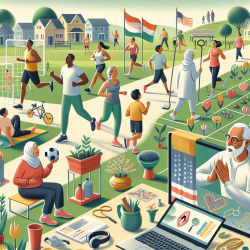A Day in the Life: Traditional In-Person vs. Online Occupational Therapy
Comparison of a day of in-person occupational therapy in a school setting vs. a day of online occupational therapy through the TinyEYE platform.
Part 1: Preparing to Begin the Day
Scenario 1: Traditional, In-Person Occupational Therapy
- 6:00 am: Alarm goes off.
- 6:05 am: Get dressed and do your hair/make-up.
- 6:30 am: Rouse your kids, getting them dressed, feeding them breakfast, packing what they need for the day, and signing permission forms that were ‘forgotten’ the night before.
- 7:30 am: Haul your occupational therapy tools to your car. Load your kids into the car, strap everyone in. Ensure everyone has their lunch, stuffed toys, juice… and everything else they will need through the day.
- 8:00 am: Load your younger children out of the car at daycare. Ensure they have all of their toys and juice, while navigating the questions and attempts at conversation by other mothers who have just dropped off their children.
- 8:05 am: Maneuver through the beginning rush-hour traffic. Attempt to drink your coffee and eat your breakfast while driving.
- 8:25 am: Drop your son off at his elementary school. Wish him a good day and steal a precious hug before he runs to join his friends.
- 8:35 am: Arrive at the school you will be delivering therapy at this morning. Load your occupational therapy tools from your car into the school while avoiding being tripped by or trampling the children playing outside.
Scenario 2: Online Occupational Therapy
- 7:40 am: Alarm goes off.
- 7:45 am: Rouse your kids, giving them their lunches and ensuring they have any other things they might need, like their favorite stuffed animals or their juice containers.
- 8:00 am: Give each of your children and your husband a hug and kiss as they head out the door for the adventures of the day.
- 8:05 am: Get dressed and do your hair/make-up.
- 8:30 am: Relax and enjoy a cup of coffee from the comfort of your home.
Part 2: Therapy Services
Scenario 1: Traditional, In-Person Occupational Therapy
- 9:00 am: Begin therapy. See four students during the course of the morning. Take notes on a notepad during each session so that you might be able to create a relevant report and plan for each student at the end of the day.
- 12:00 pm: Haul occupational therapy supplies back to car, attempting to stay dry in the rain that is now falling. Begin the 1.5-hour drive to reach the rural school you will serve this afternoon, on both good and poor highways. Hit a pothole that was hidden under the water from the rain. Fervently hope that there is no damage and that you will not find a flat tire at the end of the day.
- 1:45 pm: Arrive at the school and haul in therapy supplies. Learn that one of the two students you were supposed to see today is sick and not at school.
- 2:00 pm: Provide therapy to the remaining student, reflecting that he would benefit greatly from twice-weekly sessions but knowing that you would not be able to drive out to see him with such frequency.
- 2:45 pm: Haul your occupational therapy supplies back to your car. Notice thankfully that your car seems to be intact and your tire is not low from hitting the pothole on the way there. Retrace your route back to the city, narrowly avoiding a deer standing in the middle of the highway.
Scenario 2: Online Occupational Therapy
- 9:00 am: Log in and begin therapy. See six students, located in three different schools in the county through the course of the morning. Reflect that if you were not connecting to them online, it would have taken you an entire day to serve these six students, if you were able to see them all at all.
- 12:00 pm: Take an hour off, enjoying a relaxed lunch while reading your favorite book.
- 1:00 pm: Log back in to continue therapy. See five students, from two out-of-state schools where there is a distinct therapist shortage and students were not previously receiving any therapy services. By car, these schools would be a 10 and 13-hour drive.
- 3:30 pm: Finalize session reports, using the notes and statistics automatically created through TinyEYE’s online tracking system and the jot notes that you took during the session. Plan for tomorrow’s sessions, reflecting on the tools that both you and your students have in your ‘Tickle Trunk’ of therapy tools, and the multitude of customizable online tools available at your fingertips.
Part 3: Finishing the Day
Scenario 1: Traditional, In-Person Occupational Therapy
- 4:45 pm: Arrive at the daycare to pick up your younger children. Learn that one had been well behaved, but that the other refused to share with the other children and had had an accident which resulted in her being put in a diaper for the remainder of the day. Listen with half an ear as the attendant explains that the children must be fully potty-trained to wear ‘big kid underwear’. Haul your kids back into the car and strap them in.
- 5:00 pm: Drive your kids home. They are exhausted from their day and cramped in the backseat. Listen, resigned, as they fight over the amount of space they are each taking up. Interfere only once they begin hitting one another.
- 5:30 pm: Arrive home, hauling in your kids and all of their things. Return to the car and haul in your therapy supplies to clean them.
- 5:45 pm: Get your son set up at the kitchen table to work on his homework, and put on a TV show to keep the younger children entertained until your husband gets home.
- 6:00 pm: Begin making supper, scrounging in the fridge and freezer attempting to ensure that all the major food groups are covered. Settle on pasta, hot dogs, and peas.
- 6:30 pm: Your husband arrives home after a long day at the office. Breathe a sigh of relief knowing that your husband will take over childcare obligations now, despite not having spent any quality time with your kids today.
- 7:00 pm: Sit down for supper, eating quickly and leaving the dishes to clean later.
- 7:30 pm: Settle into your office and begin cleaning your occupational therapy supplies, thinking about the result of the day. In the background, you can hear your husband drawing a bath for one of the kids, and your older son playing with his toy cars. Think wistfully about how you would like to be out there with them, but know that you will not get your work done if you did leave the office now.
- 8:00 pm: Begin transferring and translating your handwritten notes from each student into their therapy reports, reflecting on their overall IEP goals, and next steps in achieving those goals. Jot next step notes for each as you go, that will later be turned into a plan for their next session. During this time, you are interrupted three times, as each child enters your office for a goodnight hug and kiss. You can hear your husband in the background telling them “Just a quick hug and kiss, don’t bug Mommy!”
- 9:00 pm: Pull up your planning jot notes for the students you will be seeing tomorrow, and quickly tie in activities that you can work on to reach each goal. Reorganize your therapy tool box to include only the tools necessary for the next day’s session, and put the rest into your extensive ‘therapy closet’ that you keep locked from your kids.
- 10:00 pm: Exhausted, leave the office and find your husband sitting on the couch watching the news. Note that he has cleaned up the kitchen and washed the dishes already for you. Thankful, give him a kiss and head to bed.
At the end of the day, you are exhausted and wish you had more time to spend with your own children, but are glad to be making a difference for the students you see.
Scenario 2: Online Occupational Therapy
- 4:30 pm: Defrost chicken breasts and begin preparing supper.
- 5:30 pm: Greet your husband and children as they arrive home, and sit down to a balanced supper of chicken, roasted potatoes and carrots, and a salad. Listen attentively as your children regale you with tales from the day.
- 6:00 pm: Clean up supper together with your kids, and then help your son begin his homework and get the younger children bathed and ready for bed. Play cars with your son once he is done with his homework. Once all the children are in bed, curl up with your husband on the couch as you each reflect on the successes of the day.
At the end of the day, you are satisfied and thankful that you had time both for your own children, and to make a difference in the lives of so many students.
Occupational Therapists everywhere are recognizing the advantage that online occupational therapy provides for them, their students, and their families. Students are excited about the online activities, and are engaged in their sessions. Results are achieved.
Therapists are able to spend more time with their family and friends, without needing to sacrifice the quality of work that they do, and without needing to cut back their caseload. Balance is achieved.
Would you ever consider becoming an Online Occupational Therapist?
For more information, please follow this link.










